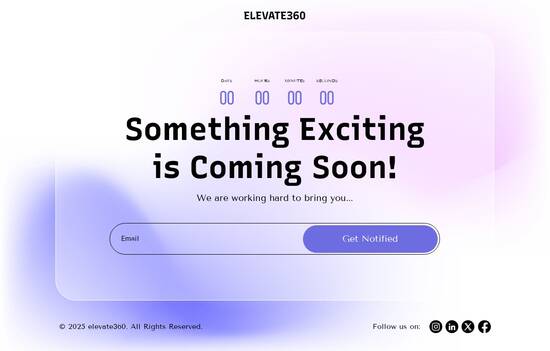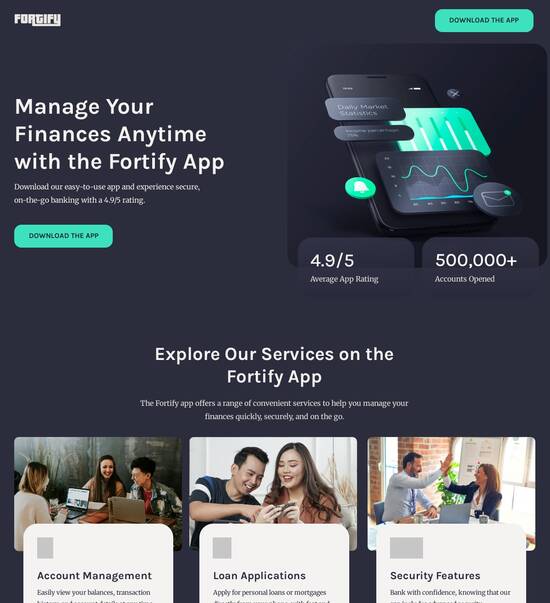
Vue.js optimized sign-up page templates
Explore Similar TemplatesAbout template
Make the most with Vue.js optimized sign-up page templates. Drive your success today.
Recommended templates

Easy to build without coding
With the intuitive drag-and-drop builder, anyone on your team can create high-converting pages without any knowledge of code or design. Make enhancements to your landing page with custom widgets using Javascript, HTML/CSS, or third-party scripts.

Multiple layouts for any industry and goal
Select from 500+ landing page layouts built to boost conversions across industry-specific scenarios. Customize them by adjusting fonts, adding images, and generating on-brand content with the AI assistant. Quickly scale with Instablocks® and Global Blocks that you can save, reuse, and update globally.

Loads fast and looks polished on any device
Every template is responsive, which means they present professionally on any device and load blazingly fast with our Thor Render Engine. You can also power them up with Google AMP technology to deliver an unparalleled mobile experience and drive higher conversions.

Robust analytics & experimentation
Get real-time updates and reporting across all your devices, showing the number of visitors, conversions, cost-per-visitor, and cost-per-lead. Launch AI-powered experiments, run A/B tests, and use heatmaps to analyze user behavior, then optimize your landing page to maximize conversions.







Easy to build without coding
With the intuitive drag-and-drop builder, anyone on your team can create high-converting pages without any knowledge of code or design. Make enhancements to your landing page with custom widgets using Javascript, HTML/CSS, or third-party scripts.
Multiple layouts for any industry and goal
Select from 500+ landing page layouts built to boost conversions across industry-specific scenarios. Customize them by adjusting fonts, adding images, and generating on-brand content with the AI assistant. Quickly scale with Instablocks® and Global Blocks that you can save, reuse, and update globally.
Loads fast and looks polished on any device
Every template is responsive, which means they present professionally on any device and load blazingly fast with our Thor Render Engine.
Robust analytics & experimentation
Get real-time updates and reporting across all your devices, showing the number of visitors, conversions, cost-per-visitor, and cost-per-lead. Launch AI-powered experiments, run A/B tests, and use heatmaps to analyze user behavior, then optimize your landing page to maximize conversions.
All the features you need to build lead-generating landing pages
Explore more featuresLearn how to build top-performing landing pages for any goal
FAQs
Leading the way in building high-performing landing pages





A powerful landing page and CRO platform for optimized marketing
In today’s competitive landscape, leveraging an effective landing page and CRO platform is essential for marketers looking to boost their return on investment (ROI). Instapage offers a versatile suite of tools designed to optimize, accelerate, and scale your digital marketing efforts. With its intuitive interface and extensive features, it allows teams of any size to drive impactful results quickly.
Getting started with Instapage
Setting up your landing pages with Instapage is a straightforward process that allows you to hit the ground running. The platform offers over 100 ready-to-use templates that cater to various industries including Tech/SaaS and Financial Services, making it easy to create high-converting pages. Here's how to initiate your landing page creation:
- Select a template: Choose from a wide range of pre-designed templates tailored to your industry.
- Customize with ease: Utilize drag-and-drop features to modify the layout, text, and images to suit your brand.
- Integrate lead generation tools: Embed forms and conversion elements directly within your landing pages.
Optimizing for conversions
Once your landing page is live, focusing on optimization is crucial for maximizing conversions. Instapage provides unique built-in features that streamline this process:
- A/B testing: Easily conduct A/B tests to compare variations of your page and determine the most effective elements.
- Heatmaps: Analyze on-page behavior with detailed heatmaps to see where visitors are engaging the most.
- Analytics dashboard: Utilize advanced analytics to track performance metrics and adjust strategies accordingly.
Personalizing your landing pages
Personalization is key to enhancing user experience and boosting conversion rates. Instapage enables marketers to create tailored experiences by:
- Dynamic text replacement: Automatically adjust text in your landing pages based on user data or traffic sources.
- AdMaps: Align specific ads to designated landing pages for improved relevance and continuity.
- Audience-level tracking: Monitor metrics and performance specific to different audience segments.
With these techniques, you not only engage your audience but also increase the likelihood of conversions.
In conclusion, Instapage stands out as an essential tool for marketers aiming to elevate their landing pages and optimize conversion rates. By leveraging its comprehensive features, teams can achieve their marketing objectives more efficiently.
Ready to transform your digital marketing campaigns? Sign up for Instapage today and take the first step towards maximizing your ROI.
People also ask about Vue.js optimized sign-up page template
Crafting a Vue.js Optimized Sign-Up Page Template: An In-Depth Exploration
Understanding the essence of Vue.js in modern web development
Vue.js has gained significant traction among developers, becoming a go-to framework for building user interfaces. One of its main appeals is its simplicity; Vue.js provides an approachable syntax which allows developers to create web applications without overcoming a steep learning curve. Key features such as a reactive data binding system and component-based architecture play pivotal roles in its popularity and effectiveness compared to other frameworks like React and Angular. Unlike React, which is heavily focused on JavaScript, Vue combines the best aspects of both React and Angular while being less complex.
The role of Vue.js in developing optimized user interfaces cannot be overstated. Its reactivity system, allowing the automatic update of DOM elements when data changes, means that user interactions remain smooth and responsive. Furthermore, its component-based design promotes reusability and organization, encouraging developers to break down UI elements into manageable pieces, which streamline collaboration and scalability in larger projects.
The sign-up page: A critical asset for user engagement
The sign-up page often serves as a gateway for new users, making its optimization essential for business success. A seamless sign-up experience not only creates favorable first impressions but also plays a significant role in user retention rates. Research indicates that a well-designed and functional sign-up process directly correlates with higher conversion rates; if users encounter obstacles while signing up, it’s likely that they will abandon the process altogether, leading to lost opportunities.
To construct a successful sign-up page, several elements are paramount. Mapping out the user journey should highlight potential pain points and barriers that might discourage sign-ups. Moreover, leveraging psychological triggers such as social proof, urgency through limited-time offers, or clarity in the value proposition can encourage users to complete the sign-up process. By understanding how to navigate these triggers, developers can create more engaging and enduring sign-up experiences.
Technologies behind a Vue.js optimized sign-up template
Creating a Vue.js optimized sign-up template requires both core features of Vue.js and supporting technologies. Core features like reactive data binding allow for instant feedback within the user interface. For instance, as users input their data, immediate validation can be presented, enhancing the overall experience. Furthermore, a component hierarchy facilitates structured organization, making it easier to maintain and scale as new features are added.
Accompanying libraries can greatly enhance a Vue.js sign-up template. Utilizing Vue Router ensures smooth navigation throughout the application, making it easier for users transitioning to different sections. Vuex acts as a centralized store for managing application state, essential for preserving user inputs across various components. Additionally, integrating third-party UI frameworks such as BootstrapVue or Vuetify can provide aesthetically pleasing and responsive design elements without extensive CSS knowledge. This collective improvement can assure a seamless and optimized user experience.
Reactive data binding for enhanced user interaction
Component hierarchy to maintain organized code architecture
Vue Router for easy navigation management
Vuex for comprehensive state management
Third-party UI frameworks for improved design
Crafting the template: A step-by-step approach
Developing a Vue.js optimized sign-up template begins with setting up the correct development environment. The initial step involves installing the Vue CLI to scaffold the project efficiently. Once the environment is ready, structuring the directory properly enhances readability and maintainability, accommodating every component logically. This organization pays off later when it’s time to expand functionalities and adapt new elements.
Next, focusing on core components is essential. The Form Component acts as the backbone of the sign-up process. By creating reusable child components like InputField and Button, developers can adhere to DRY (Don’t Repeat Yourself) principles. It’s also crucial to implement validations and error messaging to prevent users from submitting incomplete or incorrect information. Additionally, including a Q&A Section can significantly enhance user confidence. Incorporating collapsible FAQs not only organizes the information neatly but also helps clarify common concerns, reducing hesitation in the sign-up process.
Managing user inputs
Managing user inputs effectively is vital for both security and performance. To optimize performance, developers can implement debouncing techniques that limit how often input functions are executed as the user types. This prevents unnecessary processing, particularly useful in scenarios involving asynchronous validation checks, thereby enhancing the user experience. Furthermore, employing proper validation methods, including regular expressions for field validation and feedback prompts, ensures that only accurately formatted data is collected.
Incorporating a verification process can further enhance security measures. A common approach is to send a confirmation email once users complete their sign-up. This process serves not only to verify validity but also to establish user engagement from the outset. Overall, managing user inputs isn't just about gathering data; it signifies building trust and a reliable relationship with users.
Optimizing performance for a seamless user experience
Performance optimization is crucial for retaining user interest. Implementing lazy loading techniques enables developers to defer loading components until they are needed, which reduces initial load time. This practice allows users to interact with the sign-up form instantaneously while other features load in the background. Coupled with this, minimizing re-renders through Vue.js computed properties and watchers helps maintain a snappy interface, leading to an enhanced UX.
Asynchronous operations for data fetching can also be key to ensuring efficiency. Using tools like Axios or the Fetch API, developers can make asynchronous calls to interact with back-end services without blocking the UI. It’s essential also to handle any API responses and errors gracefully, providing clear notifications to users of any issues that may affect their sign-up experience. Collectively, these practices significantly empower a seamless user experience.
Enhancing usability and accessibility
When designing a sign-up page, accessibility should be a core consideration. Incorporating accessibility features such as ARIA roles and tabindex attributes ensures that users with disabilities can navigate the interface efficiently. Providing descriptive labels for inputs not only supports accessibility but also contributes to an overall clearer user experience. Moreover, following responsive design practices accommodates diverse device usage. This adaptability is essential, given the variety of screen sizes on which users may access the sign-up page.
Furthermore, adopting a mobile-first design approach focuses on ensuring usability across devices, especially since a considerable portion of traffic comes from mobile users. Techniques such as utilizing media queries allow developers to adjust layouts for optimum readability and interaction. User-centric design strategies, including A/B testing, can provide critical insights into layout improvements and user satisfaction, enabling iterative development based on real feedback.
Deploying the sign-up page template
Once the sign-up page template is ready, the next step is deployment. Choosing the right hosting solution is vital for performance and scalability. Services such as Netlify and Vercel provide remarkable support for Vue.js applications, allowing for automatic deployments and updates with ease. Implementing Continuous Integration and Deployment (CI/CD) practices ensures that new features or fixes are deployed efficiently and without downtime.
After deployment, performance monitoring is crucial. Tools like Lighthouse and GTmetrix can track page performance metrics, providing insights into load times and identifying potential bottlenecks. This is where iterative improvements come into play; making data-driven changes based on these evaluations can consistently enhance the user experience, ensuring that the sign-up page remains efficient and effective in engaging new users.
Engaging with the developer community
Engagement with the developer community is equally important for personal and professional growth. For Vue.js developers, various communities and forums, such as GitHub repositories, offer invaluable resources and templates to accelerate development processes. Developers can freely share their projects, seek advice, and review contributions from peers, enriching individual knowledge bases. Additionally, meetup groups and online collectives can foster collaborative learning and networking opportunities.
Participating in discussions, Q&A sessions, or contributing to open-source projects not only enhances one’s skills but also promotes a supportive ecosystem within the community. Sharing personal experiences through tutorials or blog posts can further aid others in their learning journeys, establishing a cycle of knowledge sharing that benefits both the contributor and the audience.
The future of Vue.js optimized templates
Looking ahead, the future of Vue.js and its optimized templates appears promising. Anticipated advancements in the framework hold the potential to further streamline development processes and enhance performance. Integrating features such as improved state management or simplified API calls may soon become standard, enabling developers to focus more on crafting engaging user experiences.
Furthermore, evolving trends in user interface design and development will likely drive innovation within the community. Encouraging experimentation with new layout strategies or UX patterns can yield remarkable results. As technology progresses, so does the opportunity for developers to create unique and engaging sign-up page templates that resonate with diverse audiences, ultimately promoting trust and loyalty across various sectors.
Ready to skyrocket conversions?
Supercharge your ad campaigns with high-performing landing pages
Get started














